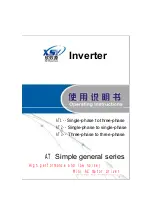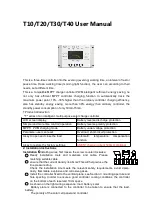
AE0ZP0EC - AC-0 SSL SENSORED - User Manual
Page - 43/100
9) STOP
ON
RAMP
Only when the encoder is present, it is possible to keep the truck on a ramp
with a released tiller.
-
ON:
The stop on ramp feature (truck electrically hold on a
ramp) is managed for a time established by AUXILIARY
TIME parameter.
-
OFF:
the stop on ramp feature is not performed. That means
the truck comes down slowly during the AUXILIARY
TIME.
After this “auxiliary time”, if the electromechanical brake is applied, the 3-
phase bridge is released; if the electromechanical brake is not present the
truck comes down very slowly (see the AUX OUTPUT #1 option
programming and see also 10.4).
10) AUX OUTPUT #1
This option handles the digital output CNA#3. It can be used one of four:
-
BRAKE:
CNA#3 drives an electromechanical Brake.
-
HYDRO CONTACTOR:CNA#3 drives the contactor for a hydraulic
steering function when the direction input or brake pedal
input are active or a movement of the truck is detected.
-
EXCLUSIVE HYDRO: CNA#3 drives the contactor for a hydraulic
steering function when the exclusive hydro input is active
(see SET INPUT #4).
-
FREE:
CNA#3 is not used.
The current this output can sink is up to 3 Adc.
11) PEDAL BRAKING
The analog input CNA#18 has one of two function:
-
Pedal Braking Input
-
Command input for lifting/lowering proportional valves in MDI-PRC
version.
To turn from the first to the second function is just enough to set PEDAL
BRAKING to NONE.
This option handles the analog input CNA#18 when used as pedal braking
input:
-
ANALOG:
With this setting is possible to modulate the strength of
the braking when the accelerator is released. The
strength of the braking is proportional to the brake pedal
potentiometer connected to this input.
When the pedal potentiometer voltage is equal less than
the SET POT BRK MIN (see “Adjustments” submenu) the
minimum release braking strength is applied (following the
RELEASE BRAKING setting).
When the pedal potentiometer voltage is equal higher
than the SET POT BRK MAX (see “Adjustments”
submenu) the maximum release braking strength is
applied (following the PEDAL BRAKING setting).
In the intermediate position, the electrical braking strength
is a linear function between the minimum (RELEASE
BRAKING) and maximum (PEDAL BRAKING) intensity.
When there is also a switch connected to the pedal
braking (i.e. SET INPUT #4 to level BRAKE), it must be
closed, otherwise the release braking is stuck to the
minimum strength disregarding the pedal potentiometer















































